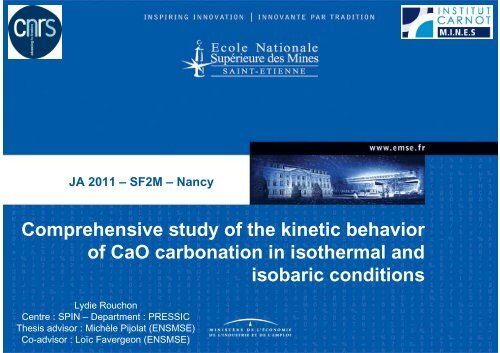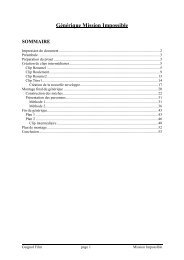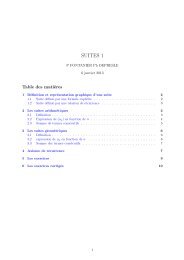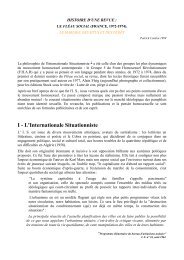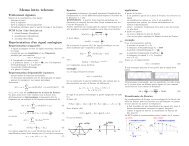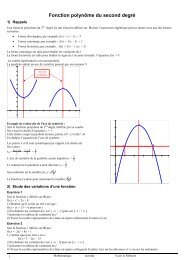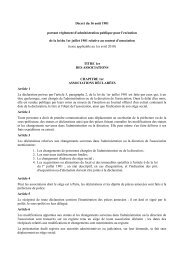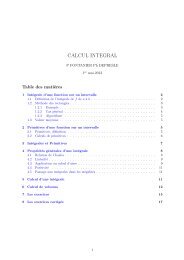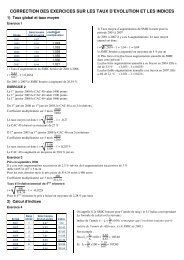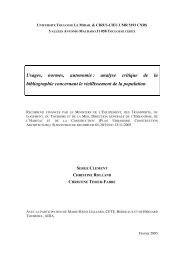Comprehensive study of the kinetic behavior of CaO carbonation in ...
Comprehensive study of the kinetic behavior of CaO carbonation in ...
Comprehensive study of the kinetic behavior of CaO carbonation in ...
Create successful ePaper yourself
Turn your PDF publications into a flip-book with our unique Google optimized e-Paper software.
JA 2011 – SF2M – Nancy<br />
<strong>Comprehensive</strong> <strong>study</strong> <strong>of</strong> <strong>the</strong> <strong>k<strong>in</strong>etic</strong> <strong>behavior</strong><br />
<strong>of</strong> <strong>CaO</strong> <strong>carbonation</strong> <strong>in</strong> iso<strong>the</strong>rmal and<br />
isobaric conditions<br />
Lydie Rouchon<br />
Centre : SPIN – Department : PRESSIC<br />
Thesis advisor : Michèle Pijolat (ENSMSE)<br />
Co-advisor : Loïc Favergeon (ENSMSE)
Tertiary Electric<br />
production<br />
Ma<strong>in</strong> activities<br />
Agriculture<br />
emitt<strong>in</strong>g<br />
CO2 Industry<br />
Residential<br />
Homes<br />
Transports<br />
Partly responsible for<br />
global warm<strong>in</strong>g<br />
2<br />
Context<br />
CO 2 (g)<br />
Lydie Rouchon – JA 2011 – SF2M – 6/07/2011<br />
CO 2 separation and capture<br />
Sorbent : <strong>CaO</strong><br />
<strong>CaO</strong> (s)<br />
CaCO 3 (s)<br />
CO 2 (g)<br />
Sequestration<br />
Problem : Such a process is limited by <strong>the</strong><br />
reversibility <strong>of</strong> <strong>the</strong> reaction
Bibliography<br />
Evolution <strong>of</strong> <strong>the</strong> capture capacity <strong>of</strong> <strong>CaO</strong> over a number <strong>of</strong> cycles<br />
• <strong>CaO</strong> rapidly loses activities towards CO 2 *<br />
• Decrease <strong>of</strong> maximum conversion rate when<br />
<strong>the</strong> number <strong>of</strong> cycles <strong>in</strong>creases<br />
• Modell<strong>in</strong>g***<br />
3<br />
Context<br />
• Model <strong>of</strong> <strong>the</strong> decay <strong>of</strong> <strong>the</strong> <strong>carbonation</strong> capacity<br />
along cycles based on s<strong>in</strong>ter<strong>in</strong>g<br />
* : Abanades, J.C. & Alvarez, D., 2003. Conversion Limits <strong>in</strong> <strong>the</strong> Reaction <strong>of</strong> CO 2 with<br />
Lime. Energy & Fuels, 17(2), 308-315.<br />
** : G.S. Grasa et al, Chemical Eng<strong>in</strong>eer<strong>in</strong>g Journal, vol. 137, Avr. 2008, pp. 561-567.<br />
*** : E. Bouquet et al, Chemical Eng<strong>in</strong>eer<strong>in</strong>g Science, vol. 64, 2009, pp. 2136-2146<br />
Lydie Rouchon – JA 2011 – SF2M – 6/07/2011<br />
• Microstructural observations**<br />
<strong>CaO</strong> after 1 calc<strong>in</strong>ation<br />
<strong>CaO</strong> after 30 cycles <strong>of</strong><br />
<strong>carbonation</strong>/de<strong>carbonation</strong><br />
• Few studies on <strong>carbonation</strong><br />
mechanism and <strong>k<strong>in</strong>etic</strong> modell<strong>in</strong>g<br />
Focuse on <strong>the</strong>se po<strong>in</strong>ts
4<br />
• Characterization <strong>of</strong> <strong>CaO</strong> divided material<br />
• De<strong>carbonation</strong> (800°C -1h00 – He flow) <strong>of</strong> CaCO 3 powder (Prolabo, Purity :<br />
99.5%)<br />
• Particle size analysis (Laser granulometer – Matsersizer 2000)<br />
• Gra<strong>in</strong>s size : 3 µm<br />
Materials and<br />
characterization<br />
• Specific surface area : BET method 6 (Micromeritics ASAP 2000)<br />
S =<br />
ρ × d<br />
• S BET : 8 m 2 .g -1 → d = 2.5 µm<br />
• SEM Observations (Microscope JEOL FEG JSM6400)<br />
Lydie Rouchon – JA 2011 – SF2M – 6/07/2011<br />
Agregate Gra<strong>in</strong><br />
10 µm 1 µm 1 µm<br />
Agregate size : ten µm Gra<strong>in</strong> size : around 1 µm
α d<br />
5<br />
• K<strong>in</strong>etic curves<br />
• Thermogravimetric analysis (TAG 16 Setaram)<br />
• Iso<strong>the</strong>rmal and isobaric conditions<br />
• Conditions : P CO2 = 5 kPa ; T <strong>carbonation</strong> = 500°C<br />
K<strong>in</strong>etic slow<strong>in</strong>g<br />
down<br />
3. Sluggish stage<br />
1. Determ<strong>in</strong>ation <strong>of</strong> an<br />
<strong>in</strong>duction period τ<br />
Experimental<br />
2. “S” shape : nucleationgrowth<br />
process<br />
ad <strong>in</strong>creases when<br />
T <strong>in</strong>creases<br />
α = 1<br />
Lydie Rouchon – JA 2011 – SF2M – 6/07/2011<br />
α ( t)<br />
=<br />
Expla<strong>in</strong> this <strong>k<strong>in</strong>etic</strong> slow<strong>in</strong>g down<br />
m(<br />
t)<br />
− m(<br />
t0<br />
)<br />
m(<br />
tf ) m(<br />
t )<br />
<strong>the</strong>o −<br />
0
6<br />
• Morphological and textural studies<br />
• BET analysis<br />
• SEM observations<br />
• BJH analysis<br />
• K<strong>in</strong>etic <strong>study</strong><br />
• Orig<strong>in</strong>al <strong>k<strong>in</strong>etic</strong> approach<br />
• Based on an experimental test<br />
• Results<br />
• Interpretations<br />
Outl<strong>in</strong>e<br />
• Conclusion and perspectives<br />
Lydie Rouchon – JA 2011 – SF2M – 6/07/2011
7<br />
Morphological and<br />
textural studies<br />
• Textural and morphological changes<br />
• Specific surface area measurements (Micromeritics ASAP 2000)<br />
• Carbonation <strong>in</strong> a tube furnace (P CO2 = 5 kPa)<br />
α d-450°C ≈ 0.22α d-550°C ≈ 0.45 α d-650°C ≈ 0.75<br />
Lydie Rouchon – JA 2011 – SF2M – 6/07/2011<br />
No direct relation<br />
between strong <strong>k<strong>in</strong>etic</strong><br />
slow<strong>in</strong>g down and<br />
decrease <strong>of</strong> specific<br />
surface area
• Morphological and textural studies<br />
8<br />
• SEM observations(JEOL FEG JSM 6400)<br />
<strong>CaO</strong> a = 0<br />
α = 0 α =<br />
Ratio <strong>of</strong> rp<strong>the</strong><br />
molar volume : z = 2,13<br />
0.8<br />
<strong>CaO</strong><br />
α = 0.05 α = 0.19<br />
1µm 1µm 1µm<br />
α = 0.36 α = 0.63 α = 0.8<br />
1µm 1µm 1µm<br />
Increase <strong>of</strong> dense gra<strong>in</strong>s size dur<strong>in</strong>g <strong>carbonation</strong><br />
Z = 2,13<br />
rp'<br />
Porosity tends to disapear<br />
CaCO 3<br />
Experimental conditions<br />
P CO2 = 5 kPa<br />
T <strong>carbonation</strong> = 550°C
9<br />
Morphological and<br />
textural studies<br />
• Textural and morphological changes<br />
• BJH analysis (Micromeritics ASAP 2000)<br />
• Carbonation <strong>in</strong> a tube furnace (T = 550°C ; P CO2 = 5 kPa)<br />
d = 3 nm<br />
d = 5 nm<br />
Lydie Rouchon – JA 2011 – SF2M – 6/07/2011<br />
Pores are<br />
not totally<br />
closed<br />
Intermediate<br />
conclusion<br />
- Slow<strong>in</strong>g down not<br />
directly l<strong>in</strong>k with decrease<br />
<strong>of</strong> specific surface area<br />
- Pores are not totally<br />
closed<br />
- Gradient <strong>of</strong> P CO2 <strong>in</strong><br />
aggregates’ pores<br />
Pay attention on<br />
<strong>the</strong> <strong>k<strong>in</strong>etic</strong> <strong>of</strong> <strong>the</strong><br />
reaction
10<br />
• Morphological and textural studies<br />
• BET analysis<br />
• SEM observations<br />
• BJH analysis<br />
• K<strong>in</strong>etic <strong>study</strong><br />
• Orig<strong>in</strong>al <strong>k<strong>in</strong>etic</strong> approach<br />
• Based on an experimental test<br />
• Results <strong>of</strong> experiment<br />
• Interpretations<br />
Outl<strong>in</strong>e<br />
• Conclusion and perspectives<br />
Lydie Rouchon – JA 2011 – SF2M – 6/07/2011
11<br />
• « ФS m » test*<br />
• Mechanism <strong>of</strong> growth process :<br />
• If ONE step is <strong>the</strong> rate determ<strong>in</strong><strong>in</strong>g step, rate can be written :<br />
• To verify this assumption :<br />
• An experimental test** : <strong>the</strong> « sudden jump » method<br />
*: M. Pijolat and M. Soustelle, Thermochimica Acta, vol. 478, 2008, pp. 34-40<br />
** : M. Soustelle, Heterogenous <strong>k<strong>in</strong>etic</strong>s handbook, Wiley-ISTE, 2010.<br />
K<strong>in</strong>etic <strong>study</strong><br />
Lydie Rouchon – JA 2011 – SF2M – 6/07/2011<br />
? ? ? ? ? ? ? ? : Areic growth rate (mol.m2 .s-1 )<br />
S m : « Space function » (m 2 .mol -1 )
12<br />
• « Sudden jump » method<br />
K<strong>in</strong>etic <strong>study</strong><br />
• To change suddenly a physico-chemical variable (P,T) from a value Y 1 to a<br />
value Y 2 , at a given fractional conversion<br />
Jumps<br />
• Verified when <strong>the</strong> ratio between <strong>the</strong> rates before and after <strong>the</strong> physicochemical<br />
variable change is constant<br />
Oxydation <strong>of</strong> Mg <strong>in</strong>to MgO by<br />
oxygen : ØS m test with temperature<br />
jumps from 773 to 783 K*<br />
Constant ratio<br />
* : K. Surla,, Thèse, Ecole des M<strong>in</strong>es de Sa<strong>in</strong>t-Etienne et Institut national Polytechnique de Grenoble, 1998.<br />
Lydie Rouchon – JA 2011 – SF2M – 6/07/2011<br />
One limit<strong>in</strong>g step
13<br />
• ØS m assumption : experiments<br />
550°<br />
C<br />
• P CO2 = 5 kPa<br />
• Change <strong>of</strong> <strong>carbonation</strong> temperature : <strong>in</strong>crease <strong>of</strong> 15°C (T 0 + 15°C = T 1 )<br />
Doma<strong>in</strong> I Doma<strong>in</strong> II<br />
K<strong>in</strong>etic <strong>study</strong><br />
α for R m<strong>in</strong> ≈ 0.5<br />
Doma<strong>in</strong> III<br />
Lydie Rouchon – JA 2011 – SF2M – 6/07/2011<br />
α d ≈ 0.5
14<br />
• ØE assumption : experiments<br />
• P CO2 = 5 kPa<br />
• Change <strong>of</strong> <strong>carbonation</strong> temperature : <strong>in</strong>crease <strong>of</strong> 15°C (T 0 + 15°C = T 1 )<br />
Inhibit<strong>in</strong>g<br />
effect <strong>of</strong><br />
temperature<br />
K<strong>in</strong>etic <strong>study</strong><br />
R=1<br />
Lydie Rouchon – JA 2011 – SF2M – 6/07/2011
• Sequence <strong>of</strong> elementary steps<br />
• ? ? ? for rate-determ<strong>in</strong><strong>in</strong>g step<br />
• Rem<strong>in</strong>der, rate ratio :<br />
15<br />
=<br />
K<strong>in</strong>etic <strong>study</strong><br />
Thermodynamic <strong>of</strong> reaction<br />
(1)<br />
(4)<br />
(3)<br />
(2)<br />
∆T =15°C<br />
→<br />
Lydie Rouchon – JA 2011 – SF2M – 6/07/2011<br />
• Comb<strong>in</strong><strong>in</strong>g <strong>of</strong> 3 and 4<br />
< 1 > 1
Thermodynamic <strong>of</strong> reaction<br />
• Quantitative <strong>in</strong>terpretation : 1. <strong>CaO</strong> particles at <strong>the</strong> periphery <strong>of</strong> aggregates<br />
16<br />
K<strong>in</strong>etic <strong>study</strong><br />
Lydie Rouchon – JA 2011 – SF2M – 6/07/2011<br />
No <strong>in</strong>hibit<strong>in</strong>g effect <strong>of</strong><br />
temperature
Thermodynamic <strong>of</strong> reaction<br />
• Quantitative <strong>in</strong>terpretation : 2. At <strong>the</strong> bottom <strong>of</strong> pores<br />
17<br />
K<strong>in</strong>etic <strong>study</strong><br />
Lydie Rouchon – JA 2011 – SF2M – 6/07/2011<br />
Inhibit<strong>in</strong>g effect <strong>of</strong><br />
temperature
• Existence <strong>of</strong> <strong>k<strong>in</strong>etic</strong> slow<strong>in</strong>g down<br />
• Textural and <strong>k<strong>in</strong>etic</strong> studies<br />
• Based on <strong>the</strong> decrease <strong>of</strong> P CO2 at <strong>the</strong> bottom <strong>of</strong> pores<br />
→ Carbonation stop<br />
• 3 doma<strong>in</strong>s <strong>of</strong> <strong>carbonation</strong><br />
• An <strong>in</strong>duction period τ<br />
• A very fast <strong>carbonation</strong> stage up to a breakpo<strong>in</strong>t<br />
• Governed by a rate determ<strong>in</strong><strong>in</strong>g step<br />
K<strong>in</strong>etic model (one fitt<strong>in</strong>g parameters) : Isotropic growth<br />
model with 1 nucleus per gra<strong>in</strong><br />
• K<strong>in</strong>etic slow<strong>in</strong>g down followed by a sluggish<br />
stage<br />
18<br />
Conclusion and<br />
Perspectives<br />
• Study porosity change as function <strong>of</strong> a<br />
• Modell<strong>in</strong>g <strong>of</strong> <strong>the</strong> overall reaction and tak<strong>in</strong>g <strong>in</strong>to account<br />
all previous assumptions<br />
Lydie Rouchon – JA 2011 – SF2M – 6/07/2011<br />
3. Sluggish stage<br />
K<strong>in</strong>etic slow<strong>in</strong>g down<br />
Model<br />
α =<br />
1<br />
α ≈ 0.3<br />
Experimental<br />
curve<br />
550°C – 5 kpa
19<br />
Thank you for your attention


